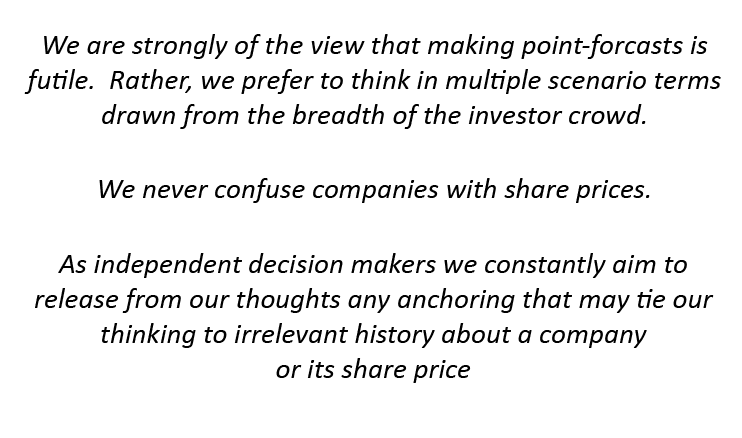Our Process

OUR PROCESS INCORPORATES both qualitative and quantitative tools. However we are mindful to never mix the art with the science of investing. Understanding the true drivers of business models enables us to distinguish between interesting data and useful information. Assessing the collective expectations of markets enables us to distinguish between market noise and news.
OUR PROCESS STARTS with identifying business models. We do this by using both quantitative screens and qualitative searching. Price changes, news catalysts, special events, industry analysis and importantly getting out globally and walking-and-talking alerts us to business models and their potential mis-pricings.
OUR FOCUS is next on understanding business models. Whether a company specialises in ‘commodities’, ‘fashion’ or ‘fads’, ‘widgets’ or ‘services’, each company is understood by assessing its ability to generate cashflow. That is, after paying suppliers, employees, tax and future investment opportunities we assess its ability to provide free cashflow for investors. We do not pretend to know everything about a company. Indeed over-optimism of knowledge leads to overconfidence which is generally associated with a decline in accuracy.
OUR ANALYSIS revolves around an assessment of the transparency, the predictability, and our understanding of each key driver of the business model. This analysis is focused on key variables and issues. We do not confuse the volume or popularity of information with its relevance. We constantly re-calibrate our thinking away from the immediacy of ideas or news to ensure we are not misled by management marketing, short-term sell-side analysts’ excitement, peer group or the 24/7 news-flow influences.
OUR AIM is to value scenarios of future free cash flows to the firm under differing assumptions. Our cashflow-based frameworks ensure that all information is captured within consistent structures and focused on medium to long term wealth creation and capital management attributes.
OUR TASK is then to compare price with our value ranges. We consider the uncertainty inherent in the future key drivers, the probability of differing outcomes and the magnitude of the consequences of those outcomes. As part of this process we re-engineer key driver inputs using the markets’ and managements’ assumptions to determine what maybe already baked-into a current share price.
OUR DISCUSSIONS, JUDGEMENTS, ADVICE AND ACTIONS are made with regard to the margin of safety the current price provides for investing. Weighing each clients’ own portfolio risk tolerance profiles against each investment the decision is then made to accept or reject the risk & return profile of the opportunity to invest and the amount of units of capital to invest. These judgements, advice and actions are framed with an acute awareness and practical understanding of the behavioural influences on decision-making.
OUR RESEARCH and analysis process is simple yet robust, combining information, discipline and patience. We repeatedly undertake this fundamental analysis using textbook models adapted and refined by ROSE OAK over the 25+ years the firm has been managing and advising wealth for, and with, our clients. Our discipline and patience enables time to compound volatility inherent in each investment option, resulting in measured and managed portfolio outcomes.
What is mis-priced
We do this by using both quantitative screens and qualitative searching. Price changes, news catalysts, special events, industry analysis and importantly getting out globally and walking-and-talking alerts us to business models and their potential mis-pricings.
Why mis-priced
We are fully aware of the investor scepticism that long-term discounted cashflow models receive and the perception of being too intricate and uncertain.
We acknowledge these difficulties, however our use of the approach does not rely on the need to produce pin-point forecasts. In fact we are strongly of the view that any investment process which places such a forecast as its heart will inevitably fail. The fundamental law of investing is the uncertainty of the future and it is a human condition to be particularly poor at forecasting it.
Drivers of Pricing
Through our focus on understanding the key drivers of a company’s value, its business and financial risks, we dramatically reduce the resources required to listen to the noise created by the army of specialists and market experts who spend time on the often fruitless exercise of forecasting short term earnings.
Range of pricing
We spend time focusing our research to assess the broad range of potential outcomes and understand how share prices may react to such shifts in expectations.
Our aim is not to form a single view, but rather to examine the collective expectations and compare them to our modelled scenarios.
Many investors place a high level of confidence in managements’ views, sell-side views, house-broker research, the implied certainty of future events or even the pattern of the recent past.
Our process allows us to efficiently aggregate the diverse views from the breadth of influences throughout the market within a disciplined, return on capital framework.
Tolerance of pricing
We do this isolated from group think (short-term) pressures, free from index-relative-constrained thinking, and with a single focus on absolute total dollars of capital created and the ‘units’ of invested capital put at risk.
Our process does not rely on a information edge in a world where information is disseminated rapidly (24/7) and to all those who choose to take it.
We have a systematic, evaluating process based on fundamental free cashflow and behavioural analysis which guides our reasoned judgements about companies, the markets’ expectations and future implications for share prices and company value.
Consequences of pricing
Our assessment of research and investment opportunities are based on both their attribution and circumstances. Each piece of information is understood individually but also collectively and always balanced against the framing of its presentation and the investing landscape.
Our research focus is on falsifying rather than verifying our views.
Confidence of price : value
That is, at what price (and over time at what exposure weighting level) can we gain exposure(s) which allows for some errors in our judgements and calculations about the future and still most likely not result in a material and permanent loss of capital to a portfolio.
We never confuse price volatility for risk. Volatility can be a great condition allowing us to buy or sell.
Share prices rise and fall with great volatility relative to the cashflows of a business.
We overlay security active risk management with portfolio risk management by accepting some higher risk opportunities but at lower exposure ‘units’ of dollars at risk and or managed with transparent, derivative protection/hedging tools.
Price and Value have different time horizons
The market frequently misprices company shares due to a range of reasons.
This includes the behavioural attraction of many investors to the short term due to;
- conflicting remuneration, mandate or employment incentives;
- career risks (including index hugging);
- lack of patience (activity versus results); or
- heuristics (rules of thumbs) being blindly followed.
We also see mispricing opportunities because of the focus on noise not news due to conflicting incentives to sell ‘stories’ because of news cycles, capital raisings, sell-downs or even from management (marketing) teams themselves.
Finally, share prices and value differ because of the continuous and volatile nature of change in expectations about the future and the common human behavioural error to extrapolate most recent changes or events.

But this is always centred around our investment axis of asymmetrical risk and absolute return focus.

